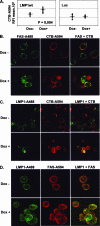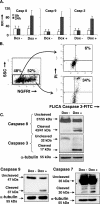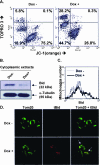Molecular basis of cytotoxicity of Epstein-Barr virus (EBV) latent membrane protein 1 (LMP1) in EBV latency III B cells: LMP1 induces type II ligand-independent autoactivation of CD95/Fas with caspase 8-mediated apoptosis
- PMID: 18448526
- PMCID: PMC2447067
- DOI: 10.1128/JVI.02250-07
Molecular basis of cytotoxicity of Epstein-Barr virus (EBV) latent membrane protein 1 (LMP1) in EBV latency III B cells: LMP1 induces type II ligand-independent autoactivation of CD95/Fas with caspase 8-mediated apoptosis
Abstract
The Epstein-Barr virus (EBV) oncoprotein latent membrane protein 1 (LMP1) is thought to act as the major transforming protein in various cell types, by rerouting the tumor necrosis factor receptor family signaling pathway. Despite this implication in EBV-associated transformation of cells, LMP1 toxicity is a well-known but poorly studied feature, perhaps because it contradicts its role in transformation. We show that LMP1 physiological levels are very heterogeneous and that the highest levels of LMP1 correlate with Fas overexpression and spontaneous apoptosis in lymphoblastoid cell lines (LCLs). To understand the cytotoxic effect of LMP1 in LCLs, we cloned wild-type LMP1 into a doxycycline double-inducible episomal vector pRT-1, with a truncated version of NGFR as a surrogate marker of inducibility. We found that LMP1 overexpression induced apoptosis in LCL B cells, as shown by annexin V labeling, sub-G(1) peak, and poly(ADP ribose) polymerase cleavage. Knocking down Fas expression by small interfering RNA abolished LMP1-induced apoptosis. The absence of detectable levels of Fas ligand mRNA suggested a ligand-independent activation of Fas. LMP1 induced Fas overexpression with its relocalization in lipid raft microdomains of the membrane. Fas immunoprecipitation detected FADD (Fas-associated death domain protein) and caspase 8, suggesting a Fas-dependent formation of the death-inducing signaling complex. Caspases 8, 9, 3, and 7 were activated by LMP1. Caspase 8 activation was associated with BID cleavage and truncated-BID mitochondrial relocalization, consistent with type II apoptosis. Therefore, our results are in agreement with a model where LMP1-dependent NF-kappaB activation induces Fas overexpression and autoactivation that could overwhelm the antiapoptotic effect of NF-kappaB, revealing an ambivalent function of LMP1 in cell survival and programmed cell death.
Figures








References
-
- Baran-Marszak, F., J. Feuillard, I. Najjar, C. Le Clorennec, J. Béchet, I. Dusanter-Fourt, G. W. Bornkamm, M. Raphaël, and R. Fagard. 2004. Differential roles of STAT1α and STAT1β in fludarabine-induced cell cycle arrest and apoptosis in human B cells. Blood 1042475-2483. - PubMed
-
- Bornkamm, G. W., C. Berens, C. Kuklik-Roos, J. Bechet, G. Laux, J. Bachl, M. Korndoerfer, M. Schlee, M. Hölzel, A. Malamoussi, R. D. Chapman, F. Nimmerjahn, J. Mautner, W. Hillen, H. Bujard, and J. Feuillard. 2005. Stringent doxycycline-dependent control of gene activities using an episomal one-vector system. Nucleic Acids Res. 33e137. - PMC - PubMed
-
- Busch, L. K., and G. A. Bishop. 1999. The EBV transforming protein, latent membrane protein 1, mimics and cooperates with CD40 signaling in B lymphocytes. J. Immunol. 1622555-2561. - PubMed
-
- Canman, C. E., and M. B. Kastan. 1995. Induction of apoptosis by tumor suppressor genes and oncogenes. Semin. Cancer Biol. 617-25. - PubMed
Publication types
MeSH terms
Substances
LinkOut - more resources
Full Text Sources
Research Materials
Miscellaneous

